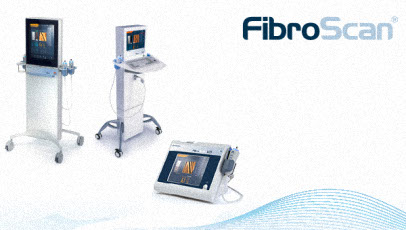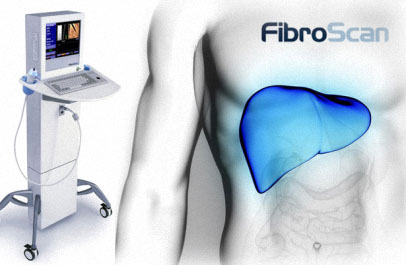

What is FibroScan/CAP®?
FibroScan is the state of art technology that will improve your liver diagnosis it is accurate and reproducible assessment of liver tissue. It is a non invasive liver stiffness measurement Innovative steatosis quantification.
FibroScan for Noninvasive Liver Diagnosis
Liver Stiffness Measurement
FibroScan is used as a cutting-edge tool at the Toronto Liver Centre and provide care to patients with any form of chronic inflammation of the liver. The technology is used in the clinical management of patients with liver disease such as chronic viral hepatitis C and B, fatty liver diseases, alcoholic liver disease, hemochromatosis, cystic fibrosis, autoimmune liver diseases, and others. The first clinically validated device using transient elastography, FibroScan measures liver shear wave speed and equivalent stiffness in a quick, non-invasive and painless procedure.
It is a painless alternative to liver biopsy for evaluating the stage of liver fibrosis. FibroScan® is used in the clinical management of patients with liver disease such as chronic viral hepatitis C and B and fatty liver diseases. Based on a technology called transient elastography, FibroScan® assesses liver shear wave speed (expressed in meter per second) and equivalent stiffness (expressed in kilopascal) at 50 Hz in a rapid, simple, non-invasive and totally painless way.
The use of non-invasive tests to stage the severity of liver disease (ie. scarring) is now well established in the management of patients with chronic liver disease. This is because assessment of liver scarring provides prognostic information and assists in establishing treatment priorities. One such technique, transient elastography (TE), is a simple, safe and efficient way to estimate liver scarring. FibroScan® is the most popular non-invasive device used to assess liver ‘hardness’ (or stiffness) via TE in Canada. When performed in the appropriate clinical setting, TE provides a reliable method of detecting cirrhosis and excluding significant fibrosis, particularly when the results are supported by clinical and laboratory data
Fatty Liver Measurement
Toronto Liver Centre offers a new tool called the Controlled Attenuation Parameter (CAP®), that measures the amount of fat within the liver. CAP® is measured at the same time as liver stiffness in the same portion of the liver. Multiple studies have confirmed the accuracy of CAP® compared with liver biopsy for both the detection of fatty liver and the quantification of fat content. Moreover, CAP® may improve following appropriate management including weight loss, improvement of diabetes and/or cholesterol control (e.g. with medications), and reduction in alcohol intake.
Toronto Liver Centre is the first centre in Canada that provides CAP®
liver stiffness measurement.
How is the test performed?
Diagnosis and evaluation of liver conditions is especially important because often times symptoms appear only after a large number of cells have been destroyed. This is typically the case for chronic
conditions which develop gradually. Early, appropriate treatment of these conditions is important and can make the lesions regress. The liver is a vital organ that handles several functions essential
to maintaining a normal physiology. Until recently, the touchstone test for diagnosis and quantification of hepatic parenchyma was livery biopsy, which an invasive, expensive exam that can be painful and on rare occasions cause hemorrhaging or death.
How is the test performed?
With the patient lying supine, an ultrasound-like probe is placed on the skin over the liver area, typically in the right mid-axillary line. The patient feels a gentle ‘flick’ each time a vibration wave is generated by
the probe. Typically the test takes around 10 minutes to perform and causes no patient discomfort. In general, patients should have fasted for at least 2 hours before the procedure, although specific
instructions may vary according to the operator.
“In comparison to the costlier alternative of a liver biopsy which can take several hours to complete, FibroScan is a 10-minute process that completely changes the way we conduct this procedure,”
The FibroScan® is typically performed as an alternative to liver biopsy. Liver biopsy is an invasive procedure that involves passing a needle through the skin into the liver to take a small piece for examination under the microscope. Due to its invasiveness, biopsy may cause complications including pain (seen in 1 in 5 patients), bleeding (1 in 1,000 patients), and/or death (1 in 10,000 patients). On the contrary, the FibroScan® is entirely non-invasive, and therefore, has no complications. Liver biopsy also requires a patient to miss a day of work whereas a FibroScan® appointment takes only 15 minutes. Lastly, biopsies sample only 1/50,000th of the liver, whereas the FibroScan® samples 1/500th of the liver (a 100-fold difference). Therefore, the FibroScan® may give more accurately assess liver health. The procedure is a less expensive alternative for identifying liver fibrosis or scar tissue. Determination of liver damage is important to help prevent complications such as liver failure and liver cancer, as well as an incentive to reverse the cause of the damage.
FibroScan, VCTE, and CAP are registered trademarks of Echosens.
What are the indications for this test?
FibroScan® is principally used to estimate the degree of liver scarring present (ie. stage of liver disease). This is very useful in the assessment of patients with chronic liver disease, including chronic hepatitis C, chronic hepatitis B, chronic alcohol abuse and fatty liver. The concept is that as more fibrosis and scarring occur, the higher the liver stiffness reading will be. This reading may be used to:
estimate the existing degree of liver damage
monitor disease progression or regression via serial measurements
guide prognosis and further management, including treatment.
FibroScan® only assesses liver stiffness and therefore does not replace conventional ultrasound. This is important to note because chronic liver disease patients usually require an ultrasound examination to assess the structural integrity of the liver, and to look for features of portal hypertension such as dilated portal vein, recanalisation of ligamentum teres, abdominal varices, and splenomegaly. In addition, conventional ultrasound should be performed at 6–12 monthly intervals to screen patients with cirrhosis for hepatocellular carcinoma. As transient elastography cannot perform these functions it is complementary to conventional ultrasound in the evaluation of liver disease. FibroScan® is much more sensitive than ultrasound for identifying less severe scarring (i.e. mild fibrosis). In other words, the greater sensitivity of the FibroScan® allows one to identify liver scarring at an earlier stage than ultrasound, and therefore start appropriate treatment before the disease is too advanced. With respect to fatty liver, the FibroScan® is also more sensitive than routine liver ultrasound and has the advantage of being able to quantify or grade the severity of fatty infiltration.
FibroScan® is superior to ultrasound for the detection of liver scarring and therefore may be used to determine if cirrhosis or advanced fibrosis is present at the initial assessment and whether it has developed during follow up because of disease progression. Furthermore, recent studies have shown that the liver stiffness provides prognostic information, particularly in subjects with chronic viral hepatitis B and C, including the risk of future liver decomposition, liver cancer and survival.
FibroScan, VCTE, and CAP are registered trademarks of Echosens.
What is FibroScan/CAP®?
Diagnosis
What are the indications for this test?


